Sun 13 May 2012
Reviewed by Walker Martin: FREDERICK NEBEL – Tough As Nails: The Complete Cases of Donahue from the Pages of Black Mask.
Posted by Steve under Characters , Pulp Fiction , Reviews[17] Comments
FREDERICK NEBEL – Tough As Nails: The Complete Cases of Donahue from the Pages of Black Mask. Altus Press, softcover, May 2012. [A limited edition hardcover may still be available.]
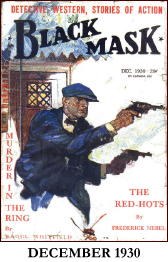
This is rapidly turning out to be the year that Frederick Nebel was rediscovered. First we had The Complete Casebook of Cardigan, Volume One, which I reviewed here. Then just recently Black Dog Books published Empire of the Devil, a collection of Nebel’s adventure tales.
Coming up later in the year will be additional volumes in the Cardigan series from Altus Press plus the complete stories from the Black Mask series starring Kennedy and MacBride. And now just published we have this latest book from Altus Press collecting all the Donahue stories from Black Mask.
Like The Complete Casebook of Cardigan, this book is a must buy for any lover of hardboiled fiction. The Donahue stories are also historically significant because in 1930 it was very obvious to Joe Shaw, the editor of Black Mask, that he was about to lose his best writer. Dashiell Hammett would be following the money to Hollywood, and no pulp magazine could compete with the enormous paychecks available from the movie industry.
Shaw asked his second best writer (Chandler did not appear until 1933) to develop a series similar to the Continental Op made famous by Hammett. I stress the word “similar” because in 1930 no one could compare to the quality of Hammett. The result was Donahue of the Interstate Detective Agency. There were 15 novelettes published between November 1930 and March 1935.
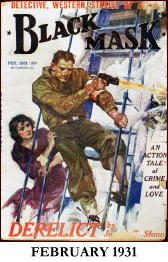
The first question readers will be asking is how do these stories stand in comparison to the Cardigan stories? The answer is simple: if you liked Cardigan, then you will like Donahue. I really do not see much of a difference between the two characters.
Like Cardigan, Donahue is tough, hardboiled, no nonsense, and a private operative working for a detective agency. We learn very little about the private lives of either character and the stories are fast moving examples of crime fiction which stand up very well even though 80 years have passed since the Cardigan and Donahue stories appeared.
The Donahue stories were written according to the above standards set by Shaw during his time as editor for Black Mask, 1926-1936. Frankly, I consider this collection another bargain from Altus Press. The quality paperback, which is almost 600 pages is available for $29.95 from Altus Press, Mike Chomko Books, and Amazon.com.
The limited edition hardcover, which I had to have because of the importance of this collection, is priced at $39.95 and can be ordered through the Altus Press website. These books are print on demand and hold up to the usual high qualities of Matt Moring, the publisher.
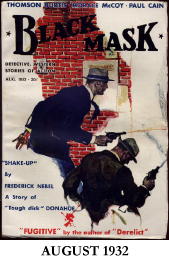
In addition to the 15 long novelettes, all 30 some pages long except for the last one which clocks in at 56 pages, the stories all have the original illustrations by the Black Mask artist Arthur Rodman Bowker. Bowker had a very distinctive style and I’ve always liked his work. He seems to fit in with the no nonsense, hard as diamonds Black Mask style. The cover is a stunner from Black Mask also, and I believe it shows Donahue(or a character very much like him), in action, gun in hand.
The introduction is by pulp historian, Will Murray, and the book is edited and compiled by Rob Preston. Rob has also compiled a bibliography of the works of Frederick Lewis Nebel. This is an important feature of the collection and runs 14 pages grouped by magazine title chronologically.
It shows that Nebel had around a hundred or so stories in the slick magazines and in addition to the fiction in Black Mask and Dime Detective, he also had over a hundred stories in other pulp magazines such as Northwest Stories, Action Stories, Air Stories, Wings, and so on. The bibliography also lists the books written by Nebel as well as the anthologies he appeared in. The screenplays based on his work are also listed.
Earlier, I mentioned that we don’t learn much of Donahue’s private life. But here are a few items of note. Donahue’s philosophy can be summed up in the passage from the first story in the series, “Rough Justice.” On page 18 Donahue says:
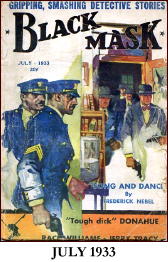
Donahue lives in a hotel apartment, made up of a small living room and bedroom. It has a bath and a small pantry. He smokes a pipe, cigarettes and cigars. He’s in his thirties, tall, lean and good looking. He eats well, attends boxing and hockey sports and says that he never gambles. He drinks brandy, scotch, martinis, wine, and beer.
Through the first 14 stories he has no girl friends, in fact he seems to mistrust the women he meets and this is understandable since they mostly turn out to be nothing but trouble. However in the last story he does meet a girl that he likes and trusts and the story ends with Donahue making a date.
Speaking of drinking, when this series commenced prohibition was still in effect across the country. I have read books about the widespread popularity of speakeasies and this series certainly shows the speakeasy as a very popular illegal hangout. They may have been illegal but everyone in NYC seemed to be drinking in these establishments including the local police.
This series shows just how impossible it was to make the general public stop drinking. It was an impossible task and prohibition just encouraged crime and corruption. None of this ever bothered Donahue and his police contacts.
I’ll repeat what I said again. This book is a must buy for all readers of the hardboiled and quality pulp fiction. Altus Press is doing excellent work reprinting such fiction and I urge everyone to support their efforts. They have some excellent books scheduled for future publication.
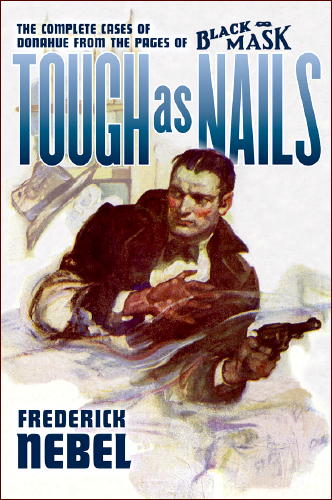
Contents:
“The Red-Hots” (December, 1930)
“Gun Thunder” (January, 1931)
“Get A Load of This” (February, 1931)
“Spare the Rod” (August, 1931)
“Pearls Are Tears” (September, 1931)
“Death’s Not Enough” (October, 1931)
“Shake-Up” (August, 1932)
“He Could Take It” (September, 1932)
“The Red Web” (October, 1932)
“Red Pavement” (December, 1932)
“Save Your Tears” (June, 1933)
“Song and Dance” (July, 1933)
“Champions Also Die” (August, 1933)
“Ghost of a Chance” (March, 1935)
Acknowledgment: The magazine covers you see above were obtained from the Galactic Central website, thanks to Phil Stephensen-Payne.
May 13th, 2012 at 11:52 pm
There’s no doubt about it. 2012 is the year many collectors of old pulp magazines have been dreaming about. Copies of BLACK MASK magazines from the 1930s are extremely scarce, and putting together a set of these 15 magazines would cost you, what, an amount in the low four figures?
Of course, if you did have a set of these 15 magazines, you’d also have plenty of other reading to go along with the Nebel stories — authors such as Dashiell Hammett, Raoul Whitfield, Paul Cain, Horace McCoy and Carroll John Daly.
Not bad, but you’d also have a set of magazines you wouldn’t dare open, for fear it fall apart on you.
A collection such as this one is the next best thing, and it won’t leave your lap filled with chips of cheap pulp paper when you’re done reading it.
May 14th, 2012 at 12:58 am
Steve mentions the price that it would cost a collector to buy these 15 issues of BLACK MASK; an amount in the low four figures. Since the November 1930 issue had Hammett’s last BLACK MASK story, that would be worth alot, perhaps $1000. The others would bring at least a couple hundred apiece since they are Shaw issues. And the prices keep going up.
When I started buying them in 1969, I paid Ron Goulart a couple dollars each for his copies that he used for his anthology, THE HARDBOILED DICKS. I found another collector here in Trenton, NJ who gladly sold me the only 5 copeis he had for $1.50 each. In other words, 40 years ago I probably spent $50 or $60 to pick up all 15 Donahue issues.
Now, not only would they cost thousands, but it would be very difficult to find them at all. These reprints are a bargain and a must buy.
May 14th, 2012 at 2:12 am
Thanks for taking the time to review these Nebel collections. It is a minor crime that Nebel did not care enough about his old stories to get them back into print, he just saw them as a paycheck and not worth resurrecting. We are very lucky that this is now changing.
I haven’t read much of his slick work, but last year I did read the WEEK END TO KILL digest from 1945 that reprints a mystery novelette from McCall’s 1938. The story was fairly boring and there was no real authorial voice to me, just a kind of bland series of events, so unlike the Cardigan series. No surprise to me no one is excited enough to see the slick work get back into print. Hard to believe Wildside reprinted this digest too a few years ago.
I agree with you, there isn’t much difference between Donahue and Cardigan, except that there are far fewer stories, hah.
The cover is from the November, 1930 issue of Black Mask, the 1st appearance of Donahue. I think it is easily the best cover used for the 15 magazines these stories appeared in.
So buy this book and others in the Nebel Library. More great collections culled from the pages of Black Mask will be coming your way over the next few years.
And a public tip of the fedora to all the contributors for copies of stories, and various bits of data (& encouragement, etc.) to this volume, I’m very pleased to see the book in print after far too many years in limbo.
May 14th, 2012 at 4:00 am
Another interesting tip !
Sure to order this one .
By the way, on most covers shown, bar one, everybody flashes a wheelgun.
Any significance to that?
The Doc
May 14th, 2012 at 6:33 am
I used to have a large collection of slick magazines such as AMERICAN, LIBERTY, COLLIERS, SATURDAY EVENING POST. I saw Nebel’s name quite often and naturally read some of them. I figured maybe he graduated out of the pulps and was writing stories of even higher quality.
I soon discovered he was writing strictly to the slick magazine formula which may have paid alot higher rates compared to his pulp fiction, but was of a lower quality, not higher as I had hoped.
It seems many slick editors encouraged their writers to slant their stories toward the so called “woman’s market”. Studies showed many of the slicks had a high percentage of women readers and the editors figured the stories should therefore have a strong romance element or be written in a sensitive style, etc. Needless to say Nebel’s hardboiled, BLACK MASK style did not fit this formula. He therefore wrote in a different style for the smooth paper magazines.
Arthur Sullivan Hoffman, the brilliant editor of ADVENTURE MAGAZINE, used to say that he did not want stories with too much “woman interest”, which was another jab at the slicks and even such pulps as ARGOSY and POPULAR MAGAZINE, which often had pretty young girls on treasure hunts, wandering through the desert fighting villains, or falling in love with the cowboy hero.
May 14th, 2012 at 6:56 am
Doc in Comment #4 brings up the interesting question of the revolver versus the automatic, a complicated subject. It may be that the artist just preferred to draw revolvers but certainly both types were in use during the time of the Donahue stories. I think it was a matter of personal preference.
I do know the automatic has a reputation for not being as accurate as the revolver but it does have more of a punch. For instance while in the army I was trained in the use of the 45 automatic because I was part of a team using mortars. Machine guns also. I guess they figured it would be easier for us to pull and fire a handgun if attacked at close quarters.
But some soldiers could not hit anything with the automatic because of the kick. But the training Sgts felt if you did hit your target, then most men would be put out of action.
But these covers are great and really capture the spirit of the magazine.
May 14th, 2012 at 7:41 am
A very good review. When you live in Germany you have nearly no chance to get any of the old Black Mask magazines. So this kind of reprints in books is wonderful. I hope some publisher will reprint all Black Mask stories by Norbert Davis.
May 14th, 2012 at 8:11 am
Thanks for reviewing this book, Walker! This was a fun book to do and I’ve tried may darndest to make all my Nebel books look like a set. And as you pointed out, there’s no better deal on pulp reprintdom than this book…. 600 pages for less that $30 will rarely be beat. And it’s a super deal vs. buying the original pulps. We priced this to move for the curious reader, as we’re that sure of its quality.
2012 is the year of Nebel. I received a proofread Cardigan Vol. 3 just a week ago, and Vol. 4 is being done now. If things go well, we’ll get the first volume of Kennedy & MacBride out by the end of the year too.
Thanks to everyone for supporting these books… it’s great fun to put them together.
May 14th, 2012 at 8:45 am
Josef: I’m sure Altus Press has some great plans for reprinting Norbert Davis, who was one of the best of the pulp authors.
Matt: One thing I’ve noticed during our meetings and conversations is your enthusiasm concerning your publishing schedule and plans for future reprints. You will hit book number 100 in the coming months and I hope it is something extra special to celebrate the occasion.
May 14th, 2012 at 11:55 am
Matt wrote:
“we’ll get the first volume of Kennedy &
MacBride out by the end of the year too.”
Sounds great. I’d love to see the originals that Hollywood somehow turned into the Torchy Blaine movies.
May 14th, 2012 at 4:39 pm
Mike mentions the Torchy Blaine movies and their origin in the Kennedy &
MacBride stories. Only the first movie in the series is even remotely related to a story. The dialogue is snappy and hardboiled in Smart Blonde, highly recommended. But the films go downhill immediately after that with some few good moments in them. Getting rid of Kennedy, making him a woman and adding in the romantic comedy was a big mistake.
May 14th, 2012 at 8:14 pm
Rob’s right about the first Torchy Blaine movie being the best, but the later ones, especially those with the wisecracking, fast-talking Glenda Farrell as Torchy, are a lot of fun, too. Women who solved mysteries before their dumb boy friends were still quite rare in the 1930s, and Torchy was one of the best.
But you absolutely do have to disassociate the movies from anything Nebel wrote. He got credit for creating the characters, that’s all. I hope he got a paycheck every time they filmed another one. There were nine in all.
May 14th, 2012 at 10:44 pm
The 9 Torchy Blaine movies are available in a Warner Brothers box set. Amazon.com has it for around $35. Glenda Farrell played a fast talking, wisecracking reporter in MYSTERY OF THE WAX MUSEUM(1933). I’ve heard that Warner Bros got the idea about Torchy Blaine from there.
Concerning the changes in character, Frederick Nebel was quoted as saying:
“Hell, they always change the stuff around. But I don’t mind–as long as I don’t have to make the changes.”
May 15th, 2012 at 12:57 am
By themselves (with no reference to the source) the Torchy Blaine films in general are good. I found one to be a dud, I forget which one fortunately. I just wish there had been a great Kennedy & MacBride 9 movie series instead…
May 15th, 2012 at 7:58 am
And if the movie-makers of the day had had any sense, there would have. But while there were a lot of good gangster movies in the 30s, they seldom knew what to do with series character mystery movies. I’m generalizing, I know, but almost always there had to be comedy relief — almost always a dopey sidekick or assistant, for example — as if the movie-going audience couldn’t sit through one that was pure mystery, whether hardboiled or the traditional puzzle-oriented kind.
PS. The two duds in the Torchy series, as far as I’m concerned, are the two in which Glenda Farrell doesn’t play Torchy. Her presence makes up for a lot of holes in the plot. In my opinion!
May 18th, 2012 at 12:45 pm
Ha, I just bought this, it’s already on it’s way. I’ve really enjoyed the Cardigan books I have (#1 & 2) and am looking forward to the Kennedy & MacBride collection!
August 20th, 2012 at 5:26 pm
The Torchy Blaine posts tickled my memory. According to IMDb SMART BLOND was based on “No Hard Feelings”. It got re-made in 1941 as A SHOT IN THE DARK featuring a news reporter named Pete Kennedy cracking wise with a Detective Lt. Ryder. Nebel was represented by Swanie Swanson, as was Chandler. It burned Chandler that he got paid only once for “Farewell, My Lovely” when it was made into movies, due to the way the contract was written. I bet the same thing happened with Nebel and “No Hard Feelings”. How does A SHOT IN THE DARK compare to SMART BLOND? Anyone care to comment?